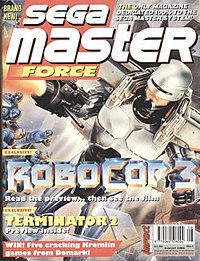Sega Force Mega

Sega Force #1, January 1992
|
|
| Editor | Stuart Wynne Roger Kean (Acting Editor) Chris Knight Steve Shields (Managing Editor) |
|---|---|
| Categories | Video game magazines |
| Frequency | Monthly |
| First issue | January 1992 |
| Final issue — Number |
July 1993 19 |
| Company |
Europress Impact Impact Magazines |
| Country | United Kingdom |
| Language | English |
| ISSN | 0964-2552 |

Sega Master Force #1, August 1993
|
|
| Editor | Steve Shields (Managing Editor) Nick Roberts |
|---|---|
| Categories | Video game magazines |
| Frequency | Monthly |
| First issue | August 1993 |
| Final issue — Number |
December 1993 6 |
| Company | Impact Magazines |
| Country | United Kingdom |
| Language | English |

Sega Force Mega #1, August 1993
|
|
| Editor | Steve Shields (Managing Editor) Mark Smith |
|---|---|
| Categories | Video game magazines |
| Frequency | Monthly |
| First issue | August 1993 |
| Final issue — Number |
January 1994 7 |
| Company | Impact Magazines |
| Country | United Kingdom |
| Language | English |
Sega Force was an early 1990s publication that covered the Sega console range (Sega Mega Drive, Mega-CD, Master System and Game Gear).
Sega Force and Nintendo Force were initially announced in mid-1991 by Newsfield. However, the liquidation of the publisher resulted in the magazine being significantly delayed. It was eventually launched by Europress Impact in December 1991.
The magazine featured artwork created by Oliver Frey that was inspired by Japanese anime, such as Akira. Frey often introduced a horror element into his artwork. His artwork for a Lemmings cover replaced the rodents with humans, depicting their horrified faces as they fell to the ground. The title also featured work by Stuart Wynne, Phil King, Steve Shields, Adrian Pitt and Matt Yeo.
The magazine occasionally featured novellas based on console games. Staff writer, Matt Yeo worked in conjunction with Acclaim software to publish a novella based on Super Smash TV. The narrative followed the plot of the computer game closely and at the end of each chapter offered readers hints and tips on how to complete the game. The narrative style was in keeping with the brash violent cartoons used within the title itself - and bore striking similarities to Stephen King's The Running Man. Sega Force's move into computer game fiction is considered to be a response to its rival Sega Power, which had already had success with several books based on computer games.
In 1993, Impact Magazines made the decision to separate the Sega Force and N-Force titles. Sega Force was split into Sega Force Mega (covering the Mega Drive and Mega-CD) and Sega Master Force (covering the Master System). Both titles featured a G-Force section that covered the Sega Game Gear.
...
Wikipedia
